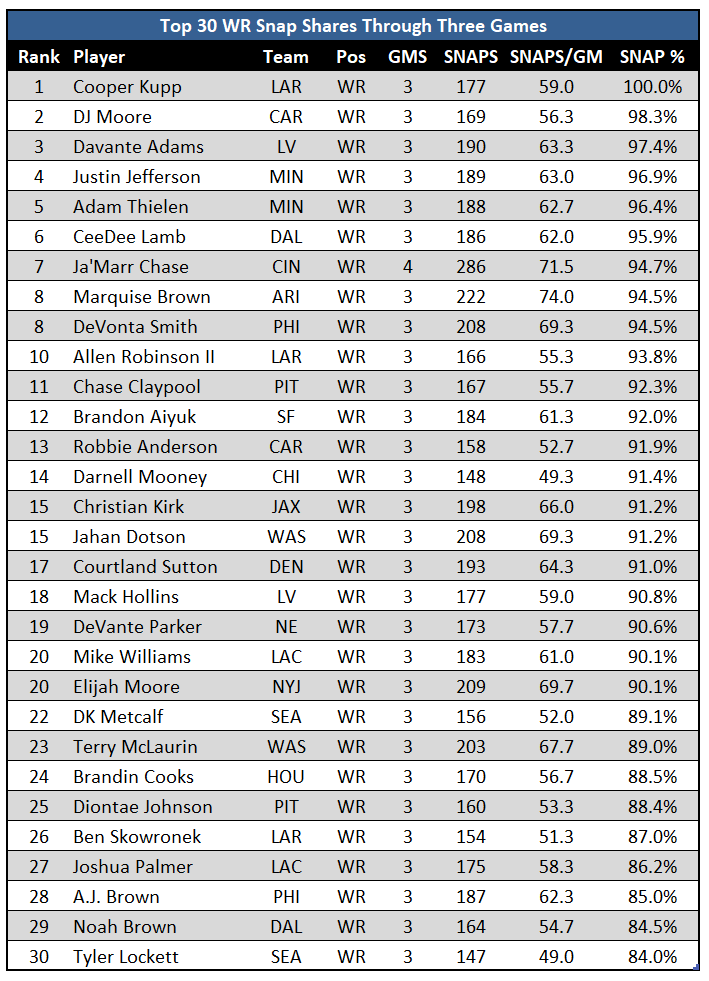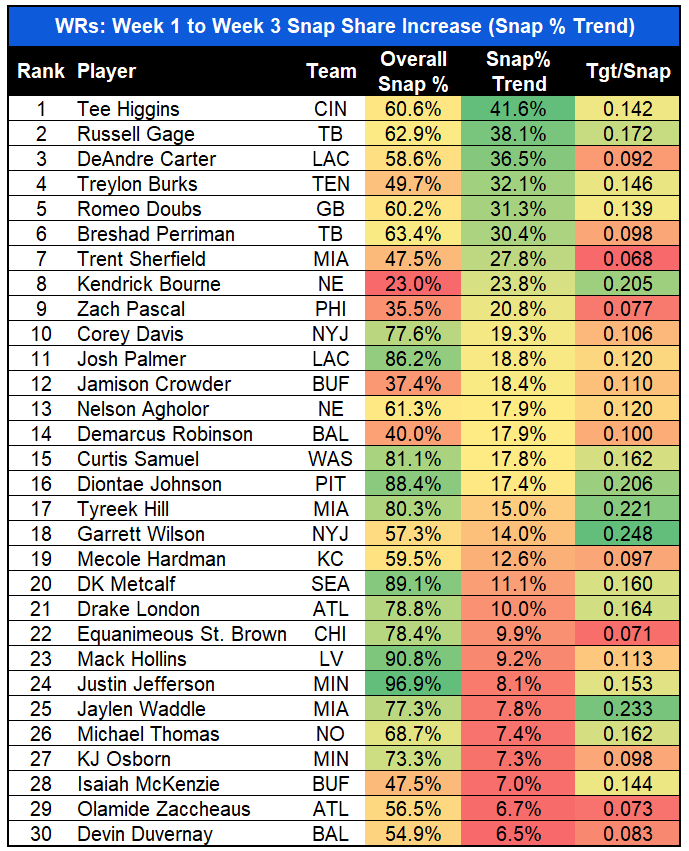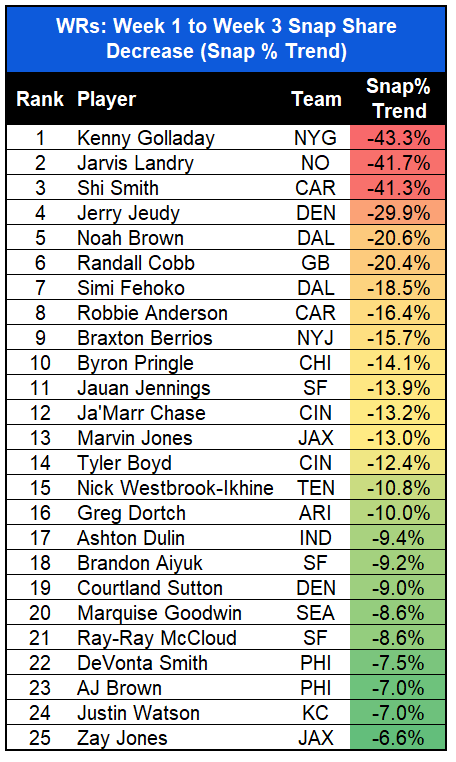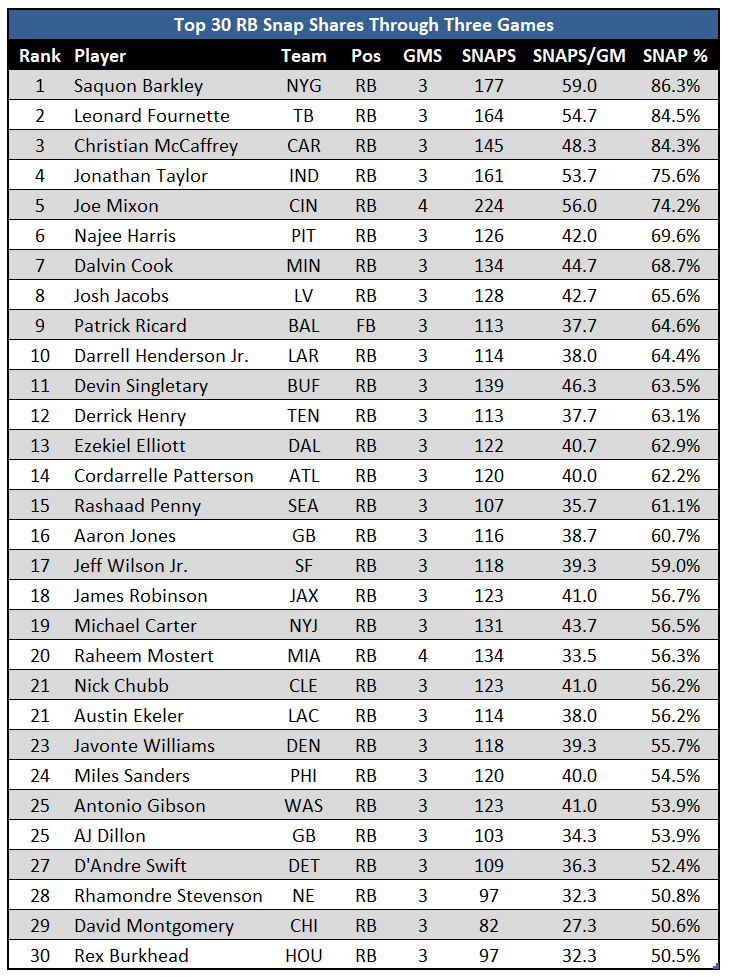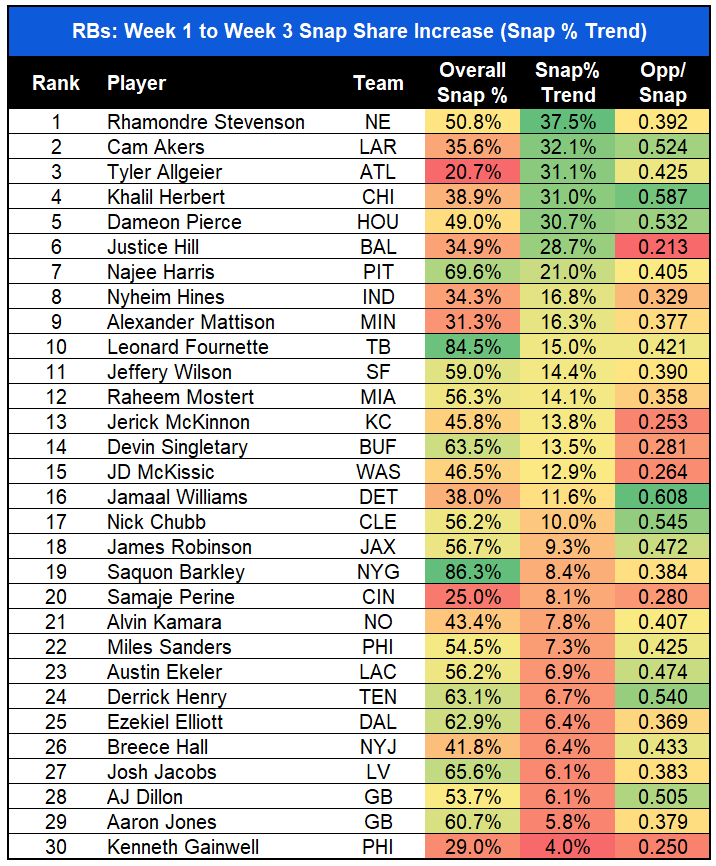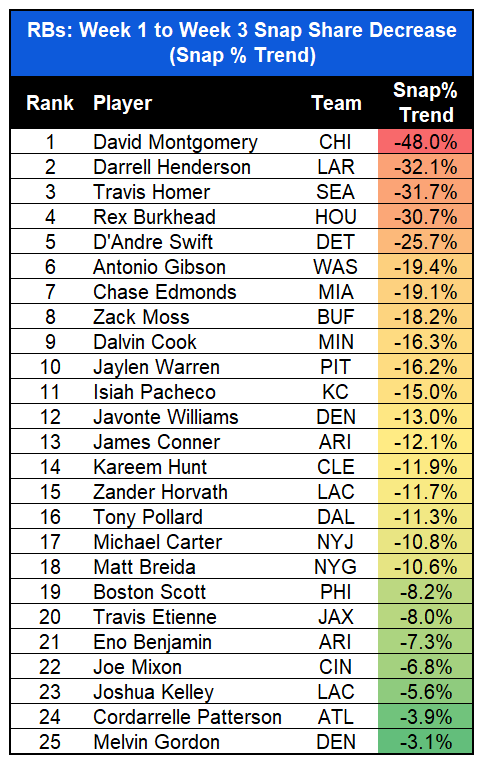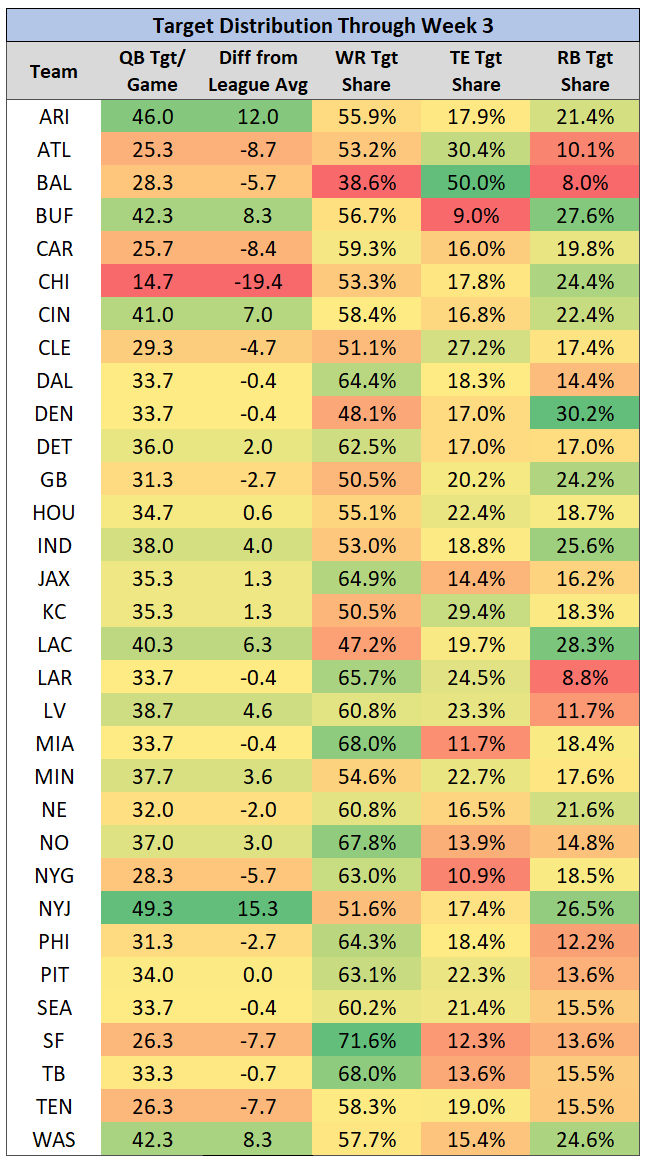Premium FantasyData Article
>>>Free to the Public this week
Another week of NFL football, another pile of data to sift through looking for clues. Clues as to what leads to certain results and clues for speculating what might be coming next. They say, “looks can be deceiving.” The same can be said for surface-level statistics in fantasy football. In this weekly article series, I will be looking beneath the statistical surface, beyond the standard box score, using the premium statistics provided by FantasyData, including advanced and efficiency metrics across the fantasy skill positions, to search for puzzle pieces that fit together.
Market Share Trends
Heading into Week 4 of the NFL season we now have data sets that become a little more indicative of what’s happening and where things may be headed, from the overall team level down to the individual player level. Three weeks of game data is still a relatively limited sample size, but certain trends begin to take shape beyond simply looking at who is scoring the most fantasy points. Market share trends that are unfolding before our eyes are one of my go-to places to start trying to decipher the story a given NFL season is telling. This likely is not surprising as most of my content for FantasyData thus far has in some way involved looking at market share statistics. This should convey how useful I find these metrics. Statistics like snap share, target share, running back rush share, opportunity share, and air yards share, to name a few, all involve something I discussed in my debut FantasyData article at length, the foundation of any potential fantasy production: Opportunity.
Simply put, the fantasy skill position players on our rosters, to score the fantasy points via receptions, rushing/receiving yards, passing yards, and touchdowns, must both earn and be given the opportunity to do so. I know this seems like it does not need to be said. A high target share for a WR, for instance, is well-known as a good thing; it is better than a low target share. But it is important to put multiple pieces of this together at the same time when the data is happening essentially in real-time. The laws of averages and regression, over time or a large enough sample size, always win out, and these concepts are also an important part of this puzzle. But each NFL season evolves and meanders differently, and fantasy football is largely a weekly endeavor. Yes, in dynasty formats there is an entirely different long-term angle from which managers must view their players, teams, and leagues. But in redraft formats, and especially in Daily Fantasy Sports (DFS) formats, it is the same goal. Win the current week.
This is where it becomes important to not only look at the total market share numbers but also look for useful trends within those numbers. I am a big fan of looking at “per game” numbers, but even that is aided by the context of trends. For this article, I will start at the ground zero for all opportunities in fantasy football. A very important statistic that by itself, paradoxically, has the least direct correlation to actual fantasy points, and that is snap share.
WR Snap Share
Starting with WRs, here are the Top 30 snap share rates so far (including Thursday Night Football of Week 4):
There are not a lot of surprises on this Top 30 leaderboard for WR snap shares thus far, especially with the players in the Top 10. However, there are some interesting names and situations that have materialized early in the 2022 season. Jahan Dotson leads all rookie WR with a 91.2% snap share, a promising sign for a rookie sharing a WR room with Terry McLaurin and Curtis Samuel. With the addition of rookie George Pickens, there was speculation that Chase Claypool might fade in the Steelers’ passing attack. But instead, Claypool is currently 20 points above his career-high snap rate (70.2% in 2021 according to FantasyData). Pickens has been part of 77.3% of the snaps. They are both on the field a lot because 75.5% of Claypool’s snaps have come in the slot, which is the third-highest rate in the league according to PlayerProfiler.com. For reference, Claypool’s slot rate in 2021 was 10.9%.
Mack Hollins being at a 90%+ snap share shows his solid start to the 2022 season has staying power. Hollins has a 17.4% target share so his 29.8 PPR point outburst in Week 3 will not be the norm, but that target share viewed by itself is misleading. The Raiders’ current pass-run ratio is 69.4%-30.6%, the second-highest team pass rate behind only the New York Jets (73.1%). Those pass rates are the product of a small sample size of only three games, so the pass-run discrepancy will decrease over the course of a full season. But the Raiders look to be one of the most pass-happy offenses in the league, so a WR in that system with a 90%+ snap share and 17.4% target share should be rostered (only 35.7% rostership on Sleeper; 12-team, 1QB format).
WR Snap Share Trends
As I said earlier, the total snap share over the first three games doesn’t necessarily tell the whole story. The following shows the positive snap share trends among WRs. This is the Top 30 WRs based on the percentage increase in snap share between Week 1 and Week 3 of the 2022 NFL Season. I have also included overall snap share and targets per snap. If an increase in snap share does not also bring with it the next level of opportunity (targets), then it’s just noise in the fantasy football world (this does not include Week 4 Thursday Night Football).
These types of in-season trends will always have lesser-known players included because this is about an increase in snap share, but not necessarily increasing to a point of much relevance for fantasy football. It should also be noted that snap share trends will spike due to injury too. Tee Higgins is at the top of this list because he got hurt during the Week 1 game, so his Week 1 snap share was only 26.0%. Then he jumped to a full workload number of 88.6% in Week 2. And some players, such as Kendrick Bourne, Trent Sherfield, Zach Pascal, and Demarcus Robinson fit the criteria of the Week 1 to Week 3 increase, but their involvement in their respective teams’ offenses is still such that they fall into the “noise” category. Bourne is a slight exception to this due to his high targets per snap. We saw Bourne have fantasy relevance last year with the same “high efficiency on low volume” result, so he is a player to monitor. But he’s only seen 44 total snaps and nine targets on the season.
The players who stand out to me in this data set are Treylon Burks, Romeo Doubs, and Russell Gage. Now, Chris Godwin is set to return and Mike Evans has served his one-game suspension, so Gage’s involvement in the Buccaneers’ offense will likely take a hit. Godwin is the Buccaneers’ slot receiver when healthy, and so far 62.9% of Gage’s snaps have come in the slot. Breshad Perriman is another Buccaneers WR in this group of 30 WR, but he hasn’t had a slot rate above 20% in his career (although it is at 20.7% in 2022). Gage’s potential continued fantasy relevance with both Godwin and Evans on the field will hinge on whether he spends more time on the outside, battling for snaps with Perriman.
Among the first-round rookie WRs, Burks is off to the slowest start, but his steady increase in snap share is a good sign and he has a respectable targets per snap of 0.146. Rookies take time to develop, even with the ridiculous early success we’ve seen with rookie WRs this season. But Burks’ increase in snap share has been organic. In this context what I mean by that is his increase has not relied on outside forces, such as injuries to other pass catchers. He is acclimating to the NFL and the Titans’ offense, and I think he is in store for a big second half of the season. Doubs ascension to the top of the Packers’ pecking order has also been organic. Allen Lazard is good for a few receptions and a TD it seems, but Doubs is making an early case to be Aaron Rodgers’ WR1 from a target and volume standpoint.
On the flip side of all this positivity is the other end of the extreme. The following table shows a Top 25 list of WRs, but these are players whose snap share have decreased the most between Week 1 and Week 3.
It is amazing how far Kenny Golladay has fallen. He does not look interested in playing football right now. A snap share decrease as extreme as Golladay’s not being due to injury tells at least the short-term story for Golladay. I do not think an outright cutting by the Giants is far away at this point.
RB Snap Share
Here are the Top 30 RB snap share rates so far (including Thursday Night Football of Week 4):
As with WRs, there are not many surprises on this list either. Devin Singletary continues to show he is the only fantasy-relevant RB in Buffalo. Zack Moss surprised everyone in Week 1 by leading the Bills’ backfield in targets, but as you’ll see on an upcoming table, his involvement has dwindled. James Cook may score some PPR fantasy points at some point, but he’s only seen 32 snaps for a 15% snap share so far. Michael Carter is seeing the field more often than Breece Hall, but Hall’s snap share is beginning to tick upward while Carter’s is heading in the opposite direction. Hall’s buying window in redraft is closing fast. Rhamondre Stevenson is on this list. Damien Harris is not, which is a good segue into the next table.
RB Snap Share Trends
The following shows the positive snap share trends among RBs. This is the Top 30 RBs based on the percentage increase in snap share between Week 1 and Week 3 of the 2022 NFL Season. I have also included overall snap share and opportunities (rush attempts plus targets) per snap (this does not include Week 4 Thursday Night Football).
The player sitting atop this list makes me happy, as I have been a Rhamondre Stevenson fan for a while. The Patriots backfield is notoriously frustrating for fantasy purposes, and it will remain that way during the 2022 season. But the takeover of the Patriots’ version of a “lead back” seems to be happening. Damien Harris’s snap share has not fluctuated much, so he is not on either list (positive or negative snap share movement). But, that steady rate is right around 38%. Stevenson now sits at an overall snap share of 50.8% but has shown the greatest increase among RBs since Week 1. Cam Akers is second on this list with a 32.1% increase since Week 1. It looks like I will end up being wrong about Akers. With Darrell Henderson dominating the RB market share in the Rams’ first game, combined with the historical data showing McVay does not utilize a committee, I thought Akers’ 2022 outlook was bleak. No, McVay did not shift to a committee approach. Rather, Akers has supplanted Darrell Henderson as the lead back for the Rams. And his 0.524 opportunities per snap are at the higher end with this group of players.
Tyler Allgeier should be added if you have an empty bench spot. Allgeier has not looked great, with only one target on the season and a 3.4 yards per carry average. But his usage has steadily increased. Allgeier is a player I wrote about previously, as someone who could end up being a deal at their ADP. My basis for that was that Allgeier could secure more of an early-down rushing role with Atlanta as the season wore on. Cordarrelle Patterson is having a fantastic season, averaging 16 rush attempts per game so far, and is the overall RB6 on the season (PPR). But I still think Patterson’s early down rush attempts will be managed as the season progresses, and Allgeier will be the benefactor of that. And if Patterson were to get injured Allgeier would be in for a heavy workload.
Khalil Herbert and Jamaal Williams have the early signs of potential “league-winner” brewing. Both have seen an uptick in involvement due to injuries in front of them, but I don’t view either as your typical RB handcuff, where they dominate the workload while the starter is out and then are relegated to full backup duties when the starter returns. I think they both have staying power regardless of what happens with David Montgomery and D’Andre Swift. And while their sample sizes are relatively small (both below 80 total snaps) which can skew certain metrics upwards, they both dominate this list of players in opportunities per snap.
As I did with WRs, here is the opposite end of the RB snap share trend, showing the Top 25 RBs based on decreased snap share since Week 1.
You see the other end of the Cam Akers discussion above. Darrell Henderson has seen the biggest decrease in snap share for a player who did not get injured. For now, the Rams’ backfield belongs to Akers. Now, the Rams do not throw to RBs much. Through three games the RB target share for the Rams is 8.8%, second-lowest to only the Ravens at 8.0%. So I still don’t see a ton of upside with Cam Akers. Dameon Pierce truthers received a scare in Week 1 when Rex Burkhead dominated the RB opportunities. But, since then, Dameon Pierce has the fifth-highest snap share increase while Burkhead has the fourth-highest snap share decrease. Similar to Akers, I do not know how lucrative being the lead RB for the Texans will end up being this year, but Pierce is that guy.
Antonio Gibson is another player falling down the snap share mountain. The concerning aspect is that it has not coincided with the return of rookie RB Brian Robinson. Robinson has not made his NFL debut yet. After a promising Week 1, Gibson’s snap share has steadily declined over the first three games while JD McKissic’s snap share (and involvement in the passing game) has increased. This does not bode well for Gibson once Robinson does return to the field.
We have already seen it in the box scores, but this data also shows the fluctuation in the Dolphins’ backfield. Outside of the TDs scored by Chase Edmonds, neither he nor Raheem Mostert has made much noise with fantasy points. But we are seeing the preference shift to Mostert as far as usage goes. Mostert’s snap share has increased 14.1% since Week 1 while Edmonds’ has decreased by 19.1%. Edmonds has scored three TDs on the season (including Week 4’s Thursday Night Football game), but he doesn’t look to be the primary RB many hoped for this year. After having 16 touches in Week 1, he’s averaged only 7.7 touches per game since (including TNF), whereas Mostert has averaged 13 touches per game in that same time frame. Edmonds can have value in the pass-catching RB role he has been in previously. The Dolphins’ RB target share is 18.4%, 15th highest in the NFL, but it will also depend on the health status of Tua Tagovailoa and how much of Teddy Bridgewater we will see this season.
This article mentioned team target shares to RBs for a few teams. Tracking team target shares to the skill positions have been very useful for me over the years in providing a layer of context as we endlessly analyze and speculate about individual players. Here is the current data through three weeks. It includes team passing volume compared to the league average as well.
Thanks for reading! If you have any questions about this article or fantasy football in general, feel free to hit me up on Twitter.
Data used for this article :

